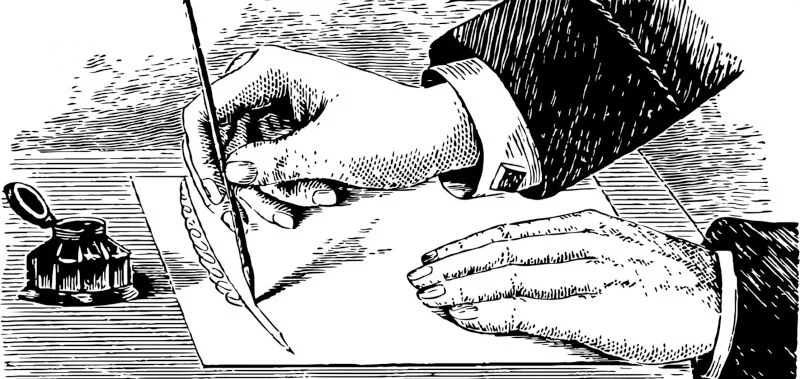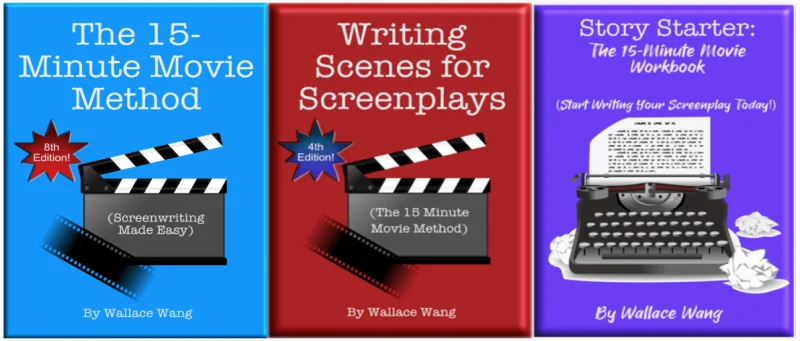
Lesson Screenwriting ABCs Storytelling Tips/Advice
The 5 Mistakes Novices Make When Writing a Screenplay
by Wallace Wang
Article, 5 pages
Viewed by: 69 Residents and 19 Guests
The 5 Mistakes Novices Make When Writing a Screenplay
By Wallace Wang
(https://15minutemoviemethod.com)

Writing is a skill that anyone can develop and screenwriting is no exception. While everyone has different amounts of natural talent, what’s far more important is how much work you’re willing to put into learning and mastering the craft of screenwriting. The more you practice, the better you’ll get.
However if you’re not careful, you risk getting tripped up by five common mistakes that can slow down or even stop your progress altogether. By recognizing these five common mistakes, you can avoid wasting time and writing screenplays with the same flaws that will keep your scripts from getting noticed.
Mistake #1: Trying to Format and Write at the Same Time
When most novices start writing screenplays, the first thing they do is rush out and buy a specialized screenwriting word processor like Final Draft. While such a tool is necessary, thinking a program like Final Draft will make you a screenwriter is like thinking that a program like Microsoft Excel will suddenly make you into a mathematical genius.
Don’t mistake tools as a replacement for talent and skill. Programs like Final Draft help you format a screenplay but until you have a story worth telling, all the proper formatting in the world won’t help you one bit.
To write a screenplay, you actually need to master two separate skills:
- Making up a story
- Formatting that story as a screenplay

The biggest mistake novices make is they try to make up their story and format it at the same time. This practically guarantees a weak, mediocre story told poorly and often formatted incorrectly as well. When you try to do two tasks simultaneously, it’s hard to do either task well.
A far better approach is to separate each task. First, make up your story. Second, format that story. This lets you concentrate on making up the best story possible and then presenting it in a compelling manner as a properly formatted screenplay.
Making up a story can be as simple as telling others your story idea. If other people’s eyes glaze over when you tell them about your story, you’ll know your story needs work. Likewise if people get excited about your story idea, that lets you know what part of your story is most appealing.
The key to making up a story is getting feedback from others. When telling stories orally, you can get feedback by watching the people who are listening to you. When telling stories as written text, you can get feedback from people who can read your story and tell you what they liked and disliked.
Making up a story is a process where you constantly modify your idea until it grabs people's attention from start to finish and makes them wish they had thought of that idea first. When your story can entertain different people on a consistent basis, that’s when you’ll know your story is ready to be turned into a screenplay.
At the basic level, formatting a screenplay involves aligning different types of text properly on a page. At a more advanced level, formatting a screenplay involves deciding on the best way to tell your story as a screenplay.
Don’t look at formatting as just a way to comply with screenplay standards. Instead, look at formatting as different tools you can use creatively for telling a story.
For example, the Scene Heading format describes where a scene takes place such as inside or out, the location such as a bar or restaurant, and the time such as day or night like this:
INT. BAR - NIGHT
 While functional, the above scene heading is plain and generic. Remember, a screenplay needs to take readers on an emotional journey so simply specifying the name of the bar can create a different emotional tone that’s best suited for your story like this:
While functional, the above scene heading is plain and generic. Remember, a screenplay needs to take readers on an emotional journey so simply specifying the name of the bar can create a different emotional tone that’s best suited for your story like this:
INT. DOUBLE DEUCE BAR - NIGHT
INT. CAPTAIN’S QUARTERS BAR - NIGHT
INT. PART TIME LOVER BAR - NIGHT
Each name of a bar evokes a different vibe and the type of people we might see there. By using formatting as a creative tool, you can make every part of your screenplay standout rather than just settling for proper formatting on the page.
Mistake #2: Not Understanding the Purpose of a Scene
The biggest mistake novices make when writing scenes is thinking the sole purpose of a scene is to give information about the story to the audience.
Wrong.
Giving information to the audience is never the purpose of any part of a screenplay. The real purpose of every scene (and every part of a screenplay) is to grab and hold someone’s attention. If your screenplay can’t grab and hold someone’s attention, nothing else will matter.
Pick up a novel you’ve never read before and flip to a random page. If what you read doesn’t grab and hold your attention, chances are good you won’t find any other part of that novel interesting either.
Screenplays work like that as well. Imagine someone flipping to a random page of your screenplay. If the text on that random page doesn’t grab and hold their attention, they’ll likely toss your script aside because they’ll know the rest of your screenplay probably won’t be worth reading.
Just as a chain is only as strong as its weakest link, so is a screenplay only as strong as its weakest scene. When you think the purpose of a scene is to give information about your story to the audience, you’ll likely write a dull scene.
Instead, if you focus on writing a scene that grabs and holds someone’s attention, you’ll write a far more dynamic scene. Then you can slip information about your story in that far more compelling scene and people will remember that information.
The purpose of every scene is to entertain the audience. How you do that depends on your particular story whether you want to evoke laughter, fear, anticipation, or excitement. The only wrong way to write a scene is to be boring.

Mistake #3: Writing Scenes in Order
Because word processors encourage people to write in a linear fashion from start to finish, far too many novices think they also need to write their screenplay starting at the beginning until they work their way all the way to the end.
While you could write a screenplay linearly, you don’t have to. In fact, it may be easier and more fun to write scenes completely out of order. Start with the scenes that most excite you. Then gradually connect your separate scenes together to tell a coherent story.
When you write a screenplay linearly, you’re far more likely to get stuck and not know what to do next. When you write a screenplay out of order, you can keep making progress by focusing on the parts of your story that you know best. Each time you finish a different scene, you’ll know more of your story so you’ll rarely feel stuck and not know what to do next.
Specialized screenplay word processors create a single file to hold your screenplay, so if you want to write scenes out of order, just store each scene in a separate file. This lets you focus on writing just that one scene and when you complete it to your satisfaction, then you can copy and paste it into your single master file.
Think of the difference between trying to write a story on a long scroll of paper (word processors) or on separate sheets of paper. Seeing a long scroll of text can get cumbersome when you just want to write a single scene. Writing a single scene separately removes those distractions.
So don’t think you have to write your story linearly. Write it in any order you wish because the end result will be a complete story anyway.

Mistake #4: Forgetting Conflict in a Scene
Stories are conflict. A story without conflict is nothing more than an essay. Conflict forces two opposing forces to fight for what they want and this struggle to get what they want is what makes all stories interesting. Strip away conflict and you remove any reason for people to care about your story.
Remember, happy people aren’t interesting to watch because there’s nothing they want to do since they’re already happy. Unhappy people are far more interesting to watch because they want to take action so they can be happy again. The big question is whether they’ll succeed or not.
Sometimes scenes contain conflict but that conflict is too weak and trivial to be interesting. Watching someone fight against a serial killer is interesting. Watching someone struggling to find their eyeglasses in the middle of the night is far less interesting. There may be conflict, but weak conflict lacks serious consequences if the person should fail. Unless, of course, that person is trying to find their eyeglasses so they can find an exit before a building explodes.
Sometimes conflict might grab and hold an audience’s attention. The problem is that the conflict in a scene has nothing to do with the rest of the story.
If the goal in a story is for someone to deliver a truck full of drugs across a third world country while being pursued by both the police and rival drug cartel gangs, a scene where the hero struggles to write a letter to his son wouldn’t make sense - unless that person were risking his life to smuggle drugs to make money because he wants to win back his son’s affection.
Any conflict within a scene must relate in some way to the conflict of the overall story. You could have the greatest fight scene ever written, but if the outcome of that fight has nothing to do with the goal of your overall story, that fight scene would be pointless.
Finally, too many novices think of conflict solely in physical terms where two people punch or shoot at each other. While interesting, external conflict will ultimately prove disappointing if there isn’t internal conflict as well.
Internal conflict makes external conflict far more interesting. Watching two people shoot at each other is mildly interesting. However, if we know that one person is the son of the police officer who’s chasing and shooting back, now the conflict’s stakes are raised because of this internal conflict.
Does the police officer really want to shoot and kill her son? Either choice could be interesting. If she wants to kill him, we want to know why. If she doesn’t want to kill him, we want to know how she might stop him before another police officer finds and shoots him instead.
Does the son know his own mother is chasing and shooting after him? That could also be an interesting choice because if he doesn’t know his own mother is trying to kill him, we might worry he could kill her.
However if the son knows his mother is chasing and shooting at him, and he’s trying to shoot back and kill her, that tells a different story than if he’s shooting back and deliberately missing in hopes he can just get away.
When you add different types of internal conflict to a scene, that internal conflict defines the choices characters make to resolve the external conflict. Knowing the internal conflict makes the consequences of the external conflict far more interesting than just wondering who might win. Instead, we want to know who might win and why they made certain choices to create that particular outcome.

Mistake #5: Failing to Rewrite Scenes
For some odd reason, novices often write a scene and when they finish formatting it as a screenplay, they move on. Remember, writing is all about rewriting. When you finish writing a scene, you’re not done. You’re just getting started.
Rewriting isn’t just about correcting spelling or editing grammatical mistakes. Instead, rewriting can also mean looking at your scene and asking yourself if that’s the best possible way to write a scene for your story.
Would a different setting be better? Is it clear what goal each character wants to achieve in a scene. What if characters had a different goal?
The more you question your scene, the less likely you’ll be satisfied with the first idea for a scene that popped into your head.
Consider writing completely different versions of the same scene. Now you can compare scenes and choose the one version that seems more effective. Write several versions of the same scene, pick the best parts from each scene, and combine them in a new version of that same scene.
The point is not to write a scene once and be done with it, but to write a scene and constantly refine it. The more you can improve a scene, the stronger your screenplay will be.
Even after you’ve polished a scene, you’ll need to re-examine it in relation to how it fits in with your other scenes. That means even your best scene may need rewriting once more. Rewriting simply gives you more options so you can find the best way to tell your story.
Summary
Learning anything new means you’re going to make mistakes, and that’s fine. Mistakes may be inevitable but making these five common mistakes can slow down your screenwriting career unnecessarily.
Keep writing, keep learning, and keep experimenting because the more you know, the more you’ll be able to tell your story in screenplay format for the rest of the world to read. Screenwriting is more than just writing one screenplay; it’s about developing the necessary skills to write multiple screenplays for as long as you want to keep working as a screenwriter.
--------------------------------------------
Check out Wallace's Website and Screenwriting books:
https://15minutemoviemethod.com/





